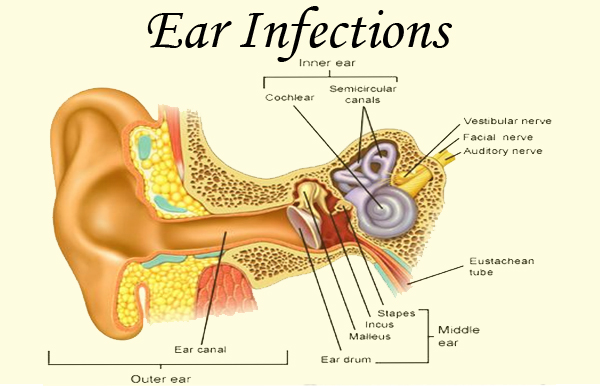An ear infection, or otitis media, happens when a person has a cold, virus, allergies, or sinus infection. This causes the Eustachian tube to swell up and close off the middle ear. Bacteria from the nose can then get into the middle ear through this passage from behind the nose to behind the eardrum. This can lead to discomfort, mild to severe pain, and hearing loss. Ear infections are common in babies and children under age 5. They’re less common but still occur in older kids and adults.
Causes of Ear Infections
The causes of ear infections can be divided into two categories: acute and chronic. Acute causes are the more common causes, which include allergic reactions to food or pollens, colds or flu viruses, middle ear infections (otitis media), swimmer’s ear (otitis external), and perforated eardrums. Chronic causes of ear infections are much less common than acute but may last longer and cause more serious damage to the ears if left untreated.
Symptoms of an ear infection
The symptoms of an ear infection vary by type of infection. The most common symptom is a pain in one or both ears, although some people experience no pain at all. Some infections can cause fluid buildup behind the eardrum, which causes a bulging spot on the eardrum and may create a crackling sound when you move your jaw or swallow. Other symptoms include fever, ear pain, not eating, as usual, being tired, having a hard time sleeping.
Types of ear infections
There are several types of ear infections. The most common is acute otitis media, which refers to an inflammation in the middle ear that causes fluid buildup and pressure. Canaliculitis is another type of ear infection that can cause pain and swell behind or within the ear canal. Other types of infections include mastoiditis, which usually affects children; barotrauma, which occurs when pressure builds up in the middle ear due to air travel.
How to prevent ear infections
Avoiding ear infections in children is a concern for parents and doctors alike. The best way to avoid the risk of infection in your child is to make sure that they are properly vaccinated before entering school. Many children suffer from ear infections each year. Although they are not much of a concern for adults, ear infections in children can be quite painful. One way to prevent these infections is to encourage your child to eat more fruits and vegetables.
Treatments for Ear Infections
Most people don’t know that there are many different treatments for ear infections. Some involve antibiotics, others don’t. Some involve surgery, others don’t. There are home remedies and some natural solutions. The important thing to remember is that if you experience symptoms of an ear infection (ear pain accompanied by fever), you should see your doctor right away before it turns into a more serious condition like meningitis or mastoiditis.
In conclusion
In this article, we’ve given you a simple explanation of what an ear infection is. If your child has been diagnosed with one, it’s important to know how to treat it properly for a healthy recovery. There are some treatments that can help with ear infections. These include antibiotics, decongestants, and natural remedies such as eardrops and essential oil drops. If your child is suffering from an ear infection, consult your doctor for the best treatment plan.








